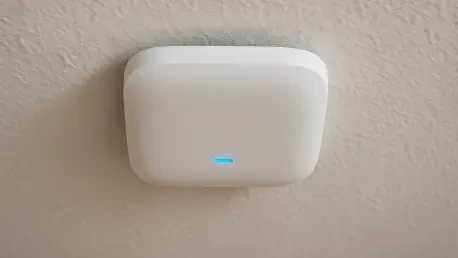In today’s fast-paced digital environment, where seamless connectivity is not just a luxury but a necessity for businesses, wireless access points (WAPs) play a pivotal role in keeping operations running smoothly across industries. For IT professionals tasked with building and maintaining robust network infrastructures, selecting the right WAP involves navigating a complex maze of performance metrics, cost considerations, and user demands. A recent comprehensive survey conducted within a global IT community, engaging over 771 respondents, offers a revealing glimpse into the minds of these decision-makers. This extensive feedback sheds light on the brands that stand out, the features that matter most, and the persistent challenges that shape purchasing decisions. By diving into these insights, a clearer picture emerges of how IT pros evaluate wireless networking solutions and what drives their preferences in an increasingly connected world.
Leading Brands in the Wireless Arena
The survey results spotlight Ubiquiti, Ruckus CommScope, and Aruba (from HPE) as the frontrunners in the WAP market, based on satisfaction ratings from a diverse pool of IT professionals. Ubiquiti emerged as the clear favorite, garnering an impressive 352 responses and consistently high marks for overall satisfaction, surpassing competitors like Cisco Meraki by a wide margin. Despite lower response counts, both Ruckus and Aruba demonstrated strong performance, particularly in specialized areas such as managing high-density user environments. This ranking, derived from evaluations of 27 different brands with a strict threshold for inclusion, underscores the trust placed in these top performers. Their ability to meet critical networking needs while maintaining user satisfaction positions them as benchmarks in a competitive landscape, offering valuable insights for organizations looking to invest in reliable wireless solutions.
Beyond the numbers, the appeal of these leading brands lies in their distinct strengths, as highlighted by the detailed feedback from respondents. Ubiquiti’s dominance is often attributed to its balance of affordability and robust functionality, making it a go-to choice for a broad range of IT setups. Ruckus, on the other hand, garners acclaim for excelling in challenging scenarios like crowded offices or educational campuses, where consistent connectivity is paramount. Aruba maintains a solid reputation for reliability, though it faces scrutiny over other aspects like cost. Meanwhile, brands like Cisco Meraki, despite a strong showing with significant responses, often fall short of top-tier status due to specific user concerns. These nuanced perspectives illustrate how satisfaction is not a one-dimensional metric but a complex interplay of features and expectations, guiding IT pros in aligning their choices with organizational priorities.
Core Priorities Driving WAP Selection
When it comes to selecting WAPs, IT professionals exhibit a clear set of priorities that shape their decision-making process. Performance stands out as a non-negotiable factor, with the need for stable, high-speed connectivity topping the list of requirements for business environments. Reliability follows closely, as downtime or inconsistent service can disrupt operations and frustrate users. Ease of management also ranks high, with IT teams favoring systems that simplify deployment and ongoing maintenance, reducing the burden on often overstretched resources. Security emerges as a critical concern, with an emphasis on strong encryption protocols and adherence to industry standards to safeguard sensitive data. These core values reflect a pragmatic approach among IT pros, who seek solutions that not only meet technical demands but also align with operational realities in diverse settings.
Another significant aspect influencing WAP choices is the capacity to support high-density environments, a feature that resonates strongly in feedback from the survey. Settings such as corporate offices, universities, or public venues demand equipment capable of handling numerous simultaneous connections without faltering. Brands that excel in this area, such as Ruckus, often receive special mention for their ability to maintain performance under pressure, a testament to their engineering focus. Additionally, compliance with evolving security norms is not just a checkbox but a fundamental expectation, as cyber threats continue to grow in sophistication. This blend of practical and strategic priorities paints a vivid picture of an IT community laser-focused on solutions that deliver both immediate functionality and long-term resilience, ensuring networks can adapt to future challenges.
Pricing: The Universal Pain Point
Across all evaluated brands, pricing emerges as the most persistent and widely discussed challenge for IT professionals assessing WAP options. The cost of hardware itself often draws criticism, but it’s the added burden of subscription-based management services that amplifies frustration, particularly with premium brands like Ruckus, Aruba, and Cisco Meraki. Despite their high satisfaction scores in performance areas, the financial barrier these costs create limits broader adoption, pushing many to seek alternatives. Respondents frequently highlighted more budget-conscious options, such as Ubiquiti’s UniFi system, which manages to deliver comparable capabilities at a lower price point. This recurring theme of cost sensitivity reveals a critical tension in the market, where value for money often outweighs even the most impressive technical specifications.
Delving deeper into the pricing dilemma, it’s evident that the issue extends beyond initial purchase expenses to long-term affordability. Subscription models, while offering ongoing updates and support, are often perceived as an unjustifiable drain on IT budgets, especially for smaller organizations or those with tight financial constraints. For high-end brands, the premium price tag is sometimes seen as lacking a proportional value proposition, with feedback pointing to competitors who provide similar reliability at reduced costs. This widespread sentiment suggests a pressing need for vendors to reconsider pricing structures, perhaps by introducing tiered options or flexible plans that cater to varying budgetary needs. Until such adjustments are made, pricing will likely remain a decisive factor, influencing not just brand preference but also the scale of wireless infrastructure deployments.
Varied Challenges and Brand-Specific Feedback
While pricing overshadows other concerns, the survey uncovers a spectrum of additional challenges that IT pros face with WAPs, varying significantly across brands. Management complexity often surfaces as a notable hurdle, with some systems criticized for unintuitive interfaces or steep learning curves that slow down deployment and troubleshooting. Coverage inconsistencies also frustrate users, particularly in expansive or architecturally complex spaces where signal strength falters. Security gaps, though less frequently mentioned, remain a worry for those prioritizing data protection. Integration difficulties with existing infrastructure further complicate matters, as compatibility issues can derail otherwise promising solutions. These diverse pain points highlight the multifaceted nature of wireless networking challenges, pushing IT teams to weigh a broad array of factors beyond just cost.
Brand-specific feedback adds another layer of insight, revealing how each frontrunner fares against unique user expectations. Ubiquiti, despite its popularity, draws criticism for troubleshooting complexities within its management console, where diagnosing issues can become a cumbersome task. Ruckus stands out for its prowess in dense environments but stumbles in areas like customer support and ease of administration. Aruba’s reliability is tempered by critiques of its pricing and management tools, while Cisco Meraki’s strong technical standing is often undermined by cost concerns that overshadow its merits. These detailed observations demonstrate that no brand is immune to criticism, and IT professionals must navigate a landscape of trade-offs, tailoring their selections to match specific operational needs and long-term strategic goals.
Shaping the Future of Wireless Networking
Reflecting on the survey’s findings, it becomes evident that IT professionals seek a harmonious blend of performance, affordability, and user-friendliness in their choice of wireless access points. The standout success of brands like Ubiquiti, Ruckus CommScope, and Aruba in satisfaction ratings points to their alignment with many of these ideals, though each faces distinct critiques. Persistent issues such as high pricing, cumbersome management systems, and troubleshooting hurdles underscore gaps that vendors need to address to better serve the market. These insights provide a valuable lens through which IT decision-makers evaluate their options, balancing immediate needs against budget realities.
Looking forward, the path to improvement seems clear for those shaping wireless solutions. Vendors should prioritize revisiting pricing models to offer more accessible options, potentially through scalable plans that accommodate diverse organizational sizes. Enhancing user interfaces to streamline management and bolstering support for troubleshooting could significantly elevate user experiences. Additionally, upcoming industry analyses, including a comprehensive report slated for release at a major IT conference in 2026, promise to delve deeper into these evolving trends. Such resources will undoubtedly equip IT pros with the knowledge to make informed decisions, while urging manufacturers to innovate in response to the nuanced demands of a dynamic networking landscape.









